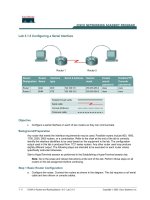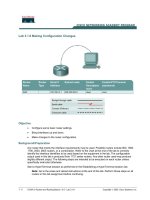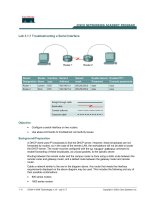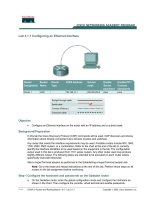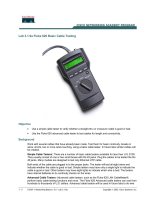Tài liệu Lab 3.1.7 Configuring an Ethernet Interface pptx
Bạn đang xem bản rút gọn của tài liệu. Xem và tải ngay bản đầy đủ của tài liệu tại đây (88.38 KB, 4 trang )
1 - 4 CCNA 2: Routers and Routing Basics v 3.0 - Lab 3.1.7 Copyright 2003, Cisco Systems, Inc.
Lab 3.1.7 Configuring an Ethernet Interface
Router
Designation
Router
Name
Router
Type
FA0/0
Address
Subnet mask
Enable
Secret
password
Enable/VTY/Console
passwords
Router 1
GAD
192.168.14.1 255.255.255.0 class cisco
Objective
• Configure an Ethernet interface on the router with an IP address and a subnet mask.
Background/Preparation
In this lab the Cisco Discovery Protocol (CDP) commands will be used. CDP discovers and shows
information about directly connected Cisco devices (routers and switches).
Any router that meets the interface requirements may be used. Possible routers include 800, 1600,
1700, 2500 and 2600 routers, or a combination. Refer to the chart at the end of the lab to correctly
identify the interface identifiers to be used based on the equipment in the lab. The configuration
output used in this lab is produced from 1721 series routers. Any other router used may produce
slightly different output. The following steps are intended to be executed on each router unless
specifically instructed otherwise.
Start a HyperTerminal session as performed in the Establishing a HyperTerminal session lab.
Note: Go to the erase and reload instructions at the end of this lab. Perform those steps on all
routers in this lab assignment before continuing.
Step 1 Configure the hostname and passwords on the Gadsden router
a. On the Gadsden router, enter the global configuration mode and configure the hostname as
shown in the chart. Then configure the console, virtual terminal and enable passwords.
2 - 4 CCNA 2: Routers and Routing Basics v 3.0 - Lab 3.1.7 Copyright 2003, Cisco Systems, Inc.
Step 2 Configure the fastEthernet 0 interface
GAD(config)#interface fastEthernet 0
GAD(config-if)#ip address 192.168.14.1 255.255.255.0
GAD(config-if)#no shutdown
GAD(config-if)#exit
GAD (config)#exit
Note: Once interface configuration mode is entered, note the ip address of the interface. Enter
the subnet mask. The command no shutdown turns on the interface. Shutdown is when the
interface is off.
Step 3 Save the configuration
a. Save the configuration information from the privileged exec command mode
GAD# copy running-config startup-config
Step 4 Display fastEthernet 0s configuration information
GAD#show interface fastethernet 0
Note: This will show the details of the Ethernet interface.
a. List at least following 3 details discovered from issuing this command.
b. FastEthernet0 is
__________________
. Line protocol is
____________________
.
c. Internet address is
___________________________.
d. Encapsulation
_________________________________
e. To what OSI layer is the “Encapsulation” referring?
______________________
Upon completion of the previous steps, logoff by typing exit. Turn the router off.
3 - 4 CCNA 2: Routers and Routing Basics v 3.0 - Lab 3.1.7 Copyright 2003, Cisco Systems, Inc.
Erasing and reloading the router
Enter into the privileged exec mode by typing enable.
If prompted for a password, enter class. If “class” does not work, ask the instructor for assistance.
Router>enable
At the privileged exec mode enter the command erase startup-config.
Router#erase startup-config
The responding line prompt will be:
Erasing the nvram filesystem will remove all files! Continue?
[confirm]
Press Enter to confirm.
The response should be:
Erase of nvram: complete
Now at the privileged exec mode enter the command reload.
Router(config)#reload
The responding line prompt will be:
System configuration has been modified. Save? [yes/no]:
Type n and then Enter.
The responding line prompt will be:
Proceed with reload? [confirm]
Press Enter to confirm.
In the first line of the response will be:
Reload requested by console.
After the router has reloaded the line prompt will be:
Would you like to enter the initial configuration dialog? [yes/no]:
Type n and then Enter.
The responding line prompt will be:
Press RETURN to get started!
Press Enter.
The router is ready for the assigned lab to be performed.
4 - 4 CCNA 2: Routers and Routing Basics v 3.0 - Lab 3.1.7 Copyright 2003, Cisco Systems, Inc.
Router Interface Summary
Router
Model
Ethernet
Interface #1
Ethernet
Interface #2
Serial
Interface #1
Serial
Interface #2
Interface
#5
800 (806) Ethernet 0 (E0) Ethernet 1 (E1)
1600 Ethernet 0 (E0) Ethernet 1 (E1) Serial 0 (S0) Serial 1 (S1)
1700 FastEthernet 0 (FA0) FastEthernet 1 (FA1) Serial 0 (S0) Serial 1 (S1)
2500 Ethernet 0 (E0) Ethernet 1 (E1) Serial 0 (S0) Serial 1 (S1)
2600 FastEthernet 0/0
(FA0/0)
FastEthernet 0/1 (FA0/1) Serial 0/0 (S0/0) Serial 0/1
(S0/1)
In order to find out exactly how the router is configured, look at the interfaces. This will identify the type of router
as well as how many interfaces the router has. There is no way to effectively list all of the combinations of
configurations for each router class. What is provided are the identifiers for the possible combinations of interfaces
in the device. This interface chart does not include any other type of interface even though a specific router may
contain one. An example of this might be an ISDN BRI interface. The string in parenthesis is the legal abbreviation
that can be used in IOS command to represent the interface.
